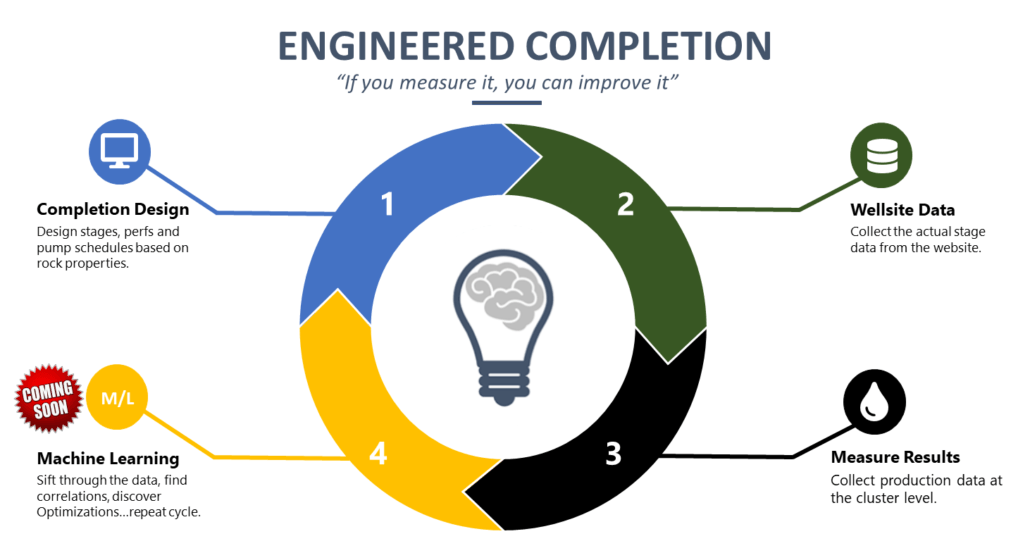Your cutting and well log data is only valuable to Operators if they can use it to make more oil or cut costs. DeepData provides a tool for Completions Engineers to directly turn your data into better completion designs. This directly impacts well productivity, while reducing costs. Instead of selling your data as interesting to geologists, you can sell it with a direct ROI tied to well outcomes. Geologists love DeepData, because it makes their insight more valuable. It makes them an integral part of the completion design process. Completions engineers love DeepData because it saves a lot of time, while making better wells.
DeepData helps Operators group similar rock in stages, resulting in more consistent fractures. It allows you to collaborate with them to select the ideal perforation locations to maximize production and avoid issues like H2S.
Well completion accounts for approximately 60% of the cost of a well, and it typically uses a geometric design that completely ignores the well’s geology. Engineers simply don’t have the tools, or the time, to incorporate geologic insights into their completion designs. Many geologists have begun questioning whether their expertise was outdated in this era of high-speed pad wells; whether they were going the way of the dinosaur. Nothing could be further from the truth, now that there’s a tool that turns geological data into better wells.
With DeepData, geologists and engineers at Operators can now turn your lab and well log data into actionable insight. In fact, DeepData enhances the value of your data so much that Operators will ask you for more data for every well, more tests, tighter intervals, more revenue to you. Turning your data into actionable insight is the key to growing your business and DeepData is the tool that makes it all possible.
"*" indicates required fields
Geo-Aware Design Optimization
DeepData is designed to enable labs, geologists and engineers to collaborate on completion design, while reducing the design time. Reducing design time is critical, because this is the primary argument against engineered, or geo-aware, completions. The completion engineer has limited time to design each well, and a geometric design–where every stage is the same and you use one pump schedule–is the only option…until now. DeepData customers report that completion design times are actually 50%-75% faster than geometric designs using Excel.
DeepData automatically incorporates your cutting data into the Operator’s design process. You start by loading your cutting data into the system. It instantly shows up on the Operator’s design for that well. Any attachments, e.g. images, comments, ternary diagrams, etc., are also associated with specific samples. All of this information is now available to the geologists and engineers at the Operator.
Operators may also solicit your expertise in defining DeepData ColorBands™ to better define rock segments for geo-aware design of stages and treatments. You might even build a practice designing completions for your Operators. Each of these value-add services can be very lucrative for your business.
There are a number of ways to optimize your completion designs that will make significant improvements in well economics by both reducing costs and increasing production. All of these optimizations are driven by designing your completion based on the rock along your lateral. Here are just a few examples:
GROUPING SIMILAR ROCK
Chose any curve (.LAS file) and DeepData will shift your clusters to target the optimal locations to hit the best rock. It doesn’t matter whether you use Gamma Ray, Drill bit geomechanics, cutting analysis, anything. You set the constraints and the target and DeepData automes the rest.
ROCK GRADING
Machine Learning enables us to correlate rock properties, physical design, treatment and results. Running all of this data through machine learning will soon drive continuous optimization.
DeepData provides the option to automatically design your stages to group similar rock. This enables a more uniform frac. For example, if a stage combines both brittle and ductile rock, the ductile rock won’t fracture (without expensive diverter), thereby reducing the efficiency of your stimulation.
CLUSTER PLACEMENT
DeepData’s patent pending process enables you to define rock quality from any combination of data. Then you can apply physical designs and pump schedules accordingly. For example you might define rocks types as: small, medium and large. When you are out of zone or in poor rock, you might reduce proppant loads by 30%, while boosting it 20% in high-quality rock. This alone can boost production while significantly reducing costs. You can apply allsorts of strategies like this, being as aggressive or conservative as you want to be.
MACHINE LEARNING - COMING SOON

The upstream E&P business is evolving along the same trajectory as automobiles. Initially all cars were custom built by hand. Then Henry Ford introduced the era of mass manufacturing, where every car was the exact same. You may have heard Henry Ford’s famous line: “Any customer can have a car painted any color that he wants so long as it is black.” Then the car business transitioned to mass customization, where each car could be tailored to customer demands. The upstream E&P business is currently in the mass manufacturing mode, with geometric completion design. DeepData is a tool that ushers you into the next phase, mass customization, where every well is optimized based on the rock properties of that unique well.
“ Using analytics to double output, thus cutting oil costs in half, means that shale break-even costs would drop to $5 per barrel–$25 per barrel. America’s shale fields would then be competitive in volume and in price with Saudi Arabia’s vaunted ultralow-cost oil fields.”

Return on Investment (ROI)
DeepData’s model is simple: Operators pay per well for a 5-year license for the Completion Design module. It includes as many users as you want at no charge. You can even invite your service providers to load data for you. This fee goes on the AFE, so the cost is shared by your NonOps.
This cost is quickly dwarfed by your ROI. The design efficiency alone pays for the license. When you consider that just a few small design wins, such as skipping out of zone segments, reducing proppant in sections with poor rock, and more the return is huge. These are the low-hanging fruit and they alone can give you a 1,500% ROI on your first well. That only addresses the cost side of the equation. Grouping similar rock for more uniform fractures, targeting perf clusters in better rock, these simple and automated actions can result in a huge ROI.
Zero-Risk Guarantee